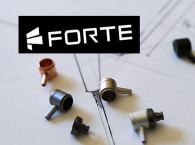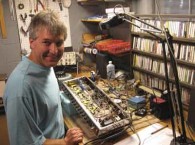7decibels Ramps Up the Volume
Innovative Sabine amplifier for iPads kicks off new business venture for its designers
SHANNON BECKER: tell us a little about your background. Where are you located? What is your education?

project manager behind the Sabine project.
TOMMY REED and ALEKSEY MATYUSHEV: We both live in Melbourne, FL. Aleksey has a BS in Aerospace Engineering and Tommy has a Master’s in Electrical Engineering.
SHANNON: What is your current occupation?
ALEKSEY: I currently work as an Aerodynamicist at a major general aviation manufacturer.
TOMMY: I work as a Project Engineer at a major defense communications company.
SHANNON: How did you become interested in audio electronics?
TOMMY: When you think about the connection people have to their music, it’s pretty incredible. Music stirs our emotions at a very personal level. I’ve always been a bit of an audiophile.

mechanical know-how and engineering skills
to make Reed’s vision a reality.
ALEKSEY: My father built a cassette player from a kit when I was young. After it was completed, you could hear Ozzy Osbourne screaming non-stop throughout our apartment. I became instantly interested in how a bunch of circuits could bring Ozzy to life.
SHANNON: Describe your first audio project. Why did you build it? Is it still in use?
TOMMY: My first audio-related project was a tone generator I created while pursuing my undergraduate degree in Electrical Engineering. It was a simple device that created about eight tones by pressing certain buttons. To me, the real magic happened when a person pressed two or more buttons at once. The tones were mixed by the device and played through a speaker. It was extremely interesting being able to understand what the electronics were doing in order to produce those mixed frequency tones.
ALEKSEY: My first audio project was a small battery-powered amplifier. I had just recently bought my first post-college car and it had no stereo in it. I had just graduated from college and needed to drive from Florida to Iowa. I hated wearing earphones for more than an hour, so I decided to wire my desktop radio speakers to an ?” connector so I could plug it into my iPod. After wiring the speakers, I plugged in the iPod, hit play, and was immediately disappointed. You could hardly hear the music. I quickly remembered that we designed a small amplifier in our electrical engineering class, so I dug out my notes, went to RadioShack, and I had a working portable radio system in a couple of hours. I was so excited, I drove 22 hours straight to Iowa.
SHANNON: Why did you turn to the online funding platform Kickstarter?
TOMMY: After Aleksey and I decided to pair up to launch Sabine [an amplifier for use with iPads], it became clear early on that Kickstarter was the perfect vehicle to bring our product to life. It’s a great way to test the market, test your price point, and get good publicity along the way. The Kickstarter community is very active, the backers are serious about supporting projects and love to see people succeed.
ALEKSEY: I have been watching Kickstarter from the sidelines for some time, and I was always itching to find a reason to put a project on there. When Tommy approached me with the idea for Sabine, I knew that it would be the perfect opportunity.
SHANNON: When did you start your company, 7decibels (www.7decibels.com)? How did you choose the name and where do you see the company going in the future?
TOMMY and ALEKSEY: 7decibels was formed in parallel to us running our Kickstarter campaign. When we hit our goal just 10 days into the campaign, we knew it was time to make everything legit.
As far as the name goes, the Internet is getting pretty small. All the creative domain names you could think of are taken. When you are bootstrapping on a budget, you want to think of something creative, simple, and memorable. We think we did an alright job with that.
SHANNON: Tell us about the Sabine. How did you come up with the idea? When did you start working on it?

TOMMY: The Sabine was an idea that has been bouncing around in my head for a couple years. As I sat idle (not pursuing the idea) other people were introducing sound amplifiers for the iPad on Kickstarter. They were all slightly different, but had one key thing in common; they were all made of cheap plastic. I knew I would never hang something like that off of my beautiful and elegant iPad.
When I finally got in touch with Aleksey and shared the idea with him, his knowledge of materials and manufacturing processes really brought Sabine to life. We chose to craft Sabine with anodized aluminum (the same material used on the iPad). The final result is the most beautiful passive sound amplifier available today.
ALEKSEY: I found Tommy’s project posted on a freelancing website. After our first conversation, I knew the idea was solid and the market segment was there. Tommy’s vision for the Sabine was so incredible that instead of taking the hourly rate he was offering, I immediately pushed for equity because I wanted to help bring the Sabine to life.
The concept was simple and I had a CAD model with some renderings ready for him that night. Two weeks later, we received our 3-D printed prototypes from Belgium. Two weeks after that, we ordered prototypes from our manufacturer in Asia. I truly believe we have the finest sound amplifier for the iPad out there.
SHANNON: What roles did each of you play in the project’s development?
TOMMY: The Sabine was much more than just a single product. Aleksey and I have a great working relationship and plans for many new products. My role focused primarily on the strategy and vision for both the Sabine and 7decibels (the company we founded in the process). It has been an amazing learning process bringing the Sabine to market while setting up the business infrastructure required to grow from a single product to a full-fledged business.
ALEKSEY: When I met Tommy, it was obvious that he had the vision to bring the Sabine to life. Tommy has been doing project management for a couple of years at his day job so we decided to leverage that expertise. I focused on getting the mechanical design done and finding manufacturers while Tommy kept us on schedule, structured the marketing campaign, developed graphics, and started crafting our Kickstater video.
Tommy and I make a great team, and I feel that is one of the main reasons Sabine and our Kickstarter campaign was such a success. Having a teammate who asks the hard questions and keeps you accountable is important. If it wasn’t for Tommy, it would have probably taken me six months to do what Tommy and I did in two months.
SHANNON: What is the project’s current status?
TOMMY and ALEKSEY: We just finished shipping the Sabines to our Kickstarter backers. We are also weeks away from finalizing our retail package design.
At that point, we will have a grand opening on our website www.7decibels.com. We are also pursuing partnerships with potential retailers who want to carry the Sabine in their stores.
SHANNON: Is the Sabine the first product you have launched through Kickstarter? Would you use Kickstarter again and why?
TOMMY: The Sabine was the first. I envision us using Kickstarter to launch the majority of our products for the reasons stated earlier. It’s a great sanity check. If a product can’t make it on Kickstarter where there is a international and a very diverse audience, it probably can’t make it anywhere. Kickstarter success doesn’t guarantee success after Kickstarter, but its a great way to launch.
ALEKSEY: I brought a couple of other products to market before the Sabine, and there was always serious financial and time risks. Will it fulfill the need? How much should we charge? How will we market it? Those questions are always hard to answer when you are just playing with the idea. Add to that tooling costs (even for prototypes) and the risk to try to bring a product to market is huge.
Kickstarter is a wonderful platform as it helps you eliminate the financial risk, market your idea, and develop a customer base. I can’t think of a single reason not to use crowdfunding to bring a product to market. Browsing through all the successful projects on Kickstarter is enough to make you get off the couch and start tinkering with something new. It is an excellent creative space.
SHANNON: Are you working on any other projects? If so, can you provide any details?
TOMMY and ALEKSEY: We are about a month away from launching the Sabine (for the iPad mini). The physical design is complete, we are just tweaking the colors a bit to get them to match the iPad mini perfectly!
We also have some other exciting ideas about docking stations and stands, but those are still shrouded in secrecy.
SHANNON: Do you have any advice for audioXpress readers who want to launch their own audio products?
TOMMY and ALEKSEY: Spend the time up front doing market research. Looking at competitors (and there are always competitors), listing your discriminators, estimating your costs of goods sold, determining your acceptable margins—all the stuff you may not care to think about when you have a really cool idea. But at the end of the day, the best solution to a problem nobody has is a terrible solution.
From a financial risk standpoint, stay away from any product that involves tooling costs (a tool or mold that must be created to produce the product). Tooling costs are heavy and chances are you won’t get it right the first time. Keep your product simple, there is nothing wrong with emulating the competition as long as you can do it better.
Focus on design. Apple ruined it for all of us. Consumers expect good looking products and are willing to pay a premium for them. A good product needs to feel like a work of art, so you can brag to your friends about it.
SHANNON: Where do you see the audio industry being 10 years from now?
TOMMY and ALEKSEY: We envision a lot more wireless technology making its way into the audio industry. Companies such as Apple with AirPlay and Sonos have already demonstrated the technology, but the adoption has been limited by the high cost of ownership. I think the market is ripe for a company that can replace the wires with simple and cost-effective wireless solutions.
With the introduction of multiple Internet-based music platforms (e.g., Pandora and Spotify), it is clear that most music will not be held in iPods or on computer hard drives, it will be streamed from the Internet.
There is a definite market for a simple and elegant device that will connect to those services and allow the user to play music with the slightest human effort. Producing a usable human interface will be key in creating that winner.






